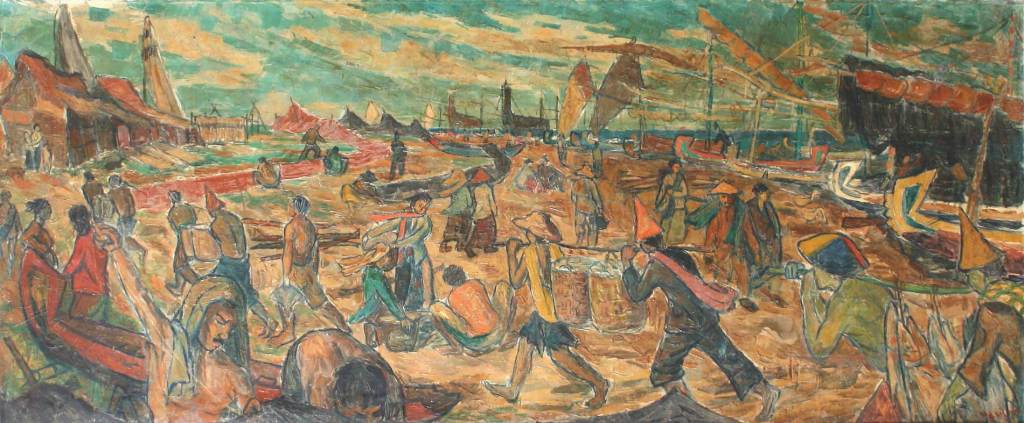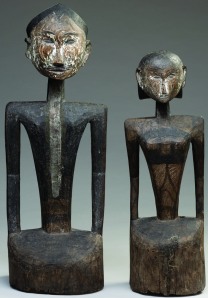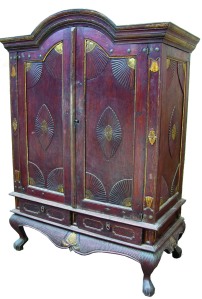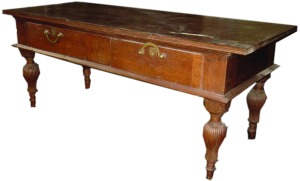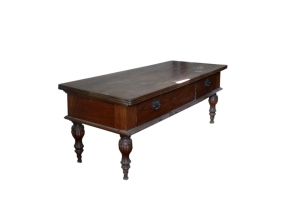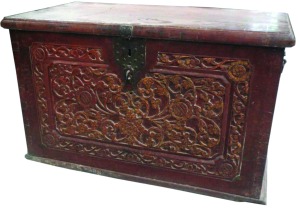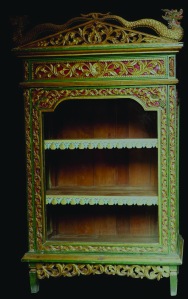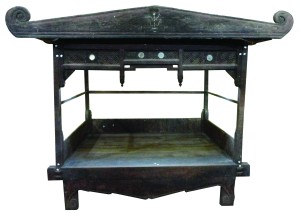Here is a selection of the items from the David B. Smith Collection that will be auctioned at the SIDHartA Auctioneer Tempo Doeloe auction, at the Bali Art Center, Jl. Nusa Indah, Denpasar, this Sunday, 11 March 2012, starting at 1:30 pm.
For the e-catalog, please visit:
http://sidhartaauctioneer.com/ecat/2012/va11032012/[slideshow]
007
Chest (grobog)
East Java | 19th century | teak wood | h: 97cm, w: 185cm, d: 85cm
These three chests mix geometric and natural patterns with flair. Unusually, the geometric decoration on the upper half of the chest is divided into two identical halves featuring a lattice-work pattern. The skirt above the wheels features a row of leaves, probably those of the betel plant, with halo-like outlines.
Publ: JAFFA , p. 260 - iv.07
008
Cabinet | East Java | 19th century | teak wood | 133 x 90 x 50cm
While the close connection between traditional Javanese architecture and furniture is irrefutable. The solid rectangular dimensions of this country cabinet are enluvened by vigorous carving and color forming two pairs of stylised birds on the top and bottom of each of the doors.
Publ: JAFFA , p. 109 - i.41
011
Cabinet | East Java | 19th century | teak wood | h: 145 cm, w: 145 cm, d: 58 cm
The doors and sides of this cabinet, dated 1878, feature tree-of-life motifs formed by luxuriant meandering green leaves against a red background. Stylised vulvas or seeds, symbols of fertility, are seen at the base of their trunks. Publ: JAFFA , p. 74 - i.02
020
Cabinet
East Java | 19th century | wood | h: 175 cm, w: 110 cm, d: 47cm
With minimal detail, two naga dragons, with what appears to be aquatic birds on their backs, bite on a central disc. The carving on the front doors is reminiscent of that of several cabinets seen on the previous pages. Publ: JAFFA , p. 112 - i.55
021
Massive Kitchen Cabinet (lemari dapur) | wood | Ponorogo, East Java | 19th century | h: 147 cm, w: 85 cm, d: 70 cm Featuring a crenellated upper rim, this rustic country pantry can be compared to traditional rice barns. The long legs, which raise it high above the ground, are intended to prevent vermin from stealing the food inside. The black patina was caused by soot from the kitchen fire. Publ: JAFFA , p. 110 - i.42
023
Massive Teakwood Cabinet with Square Wheels
East Java | 19th century | teak wood | h: 146 cm , w: 92 cm, d: 60 cm
Under normal circumstances, the rustic, rough-hewn cabinets of Ponorogo are impressive for their raw power. Publ: JAFFA , p. 111 - i.45
029
Loro Bionyo | Ponorogo, East Java | left: 28 x28 x 52 cm | right: 27 x 39 x 55 cm | Late 18th or early 19th century This wedding effigy statues of East Java’s petty aristoctracy and landed gentry are usually far more vigorous and less refined. The male reperesents Mas Sadono, sits cross-legged (padma asana), wearing a batik long cloth. His wife, Dewi Sri, wears a kamben breast cloth that exposes her shoulders, which are stained yellow from the application of turmeric powder. The figures’ torsos are elongated with narrow waists bound by wide belts with elaborate belt buckle, creating an hour-glass shape. Both wear Hindu-inspired necklace. Their mask-like white faces and large ears, a sign of wisdom, mirror the height of their position an class. Publ: JAFFA , p. 140 - ii.01
030
Room Divider | East Java | wood | h: 222cm, w: 207 cm , d: 45cm
Shaped like triptychs of cathedral windows, these remarkable room dividers were also believed to have magical protective powers, not unlike the aling-aling walls of Balinese temples. This belief is also revealed in the imagery. Publ: JAFFA , p. 176 - ii.75
031
Large Chest (grobog)
Ponorogo, East Java | 19th century | teak wood | h: 85cm, w: 200cm, d: 93cm
The rigorous, almost three-dimensional carving on these chests exemplifies a style that developed in the Ponorogo region in the second half of the 19th century. There is a tree of life with meandering lianas and spiky leaves. The skirts undulate. Unlike most grobog, the` chests are opened not by simply lifting the lids (usually made of one piece of wood) but by lifting one of several planks held by the framed tops. .
Publ: JAFFA, p. 268 - iv. 15
036
Large Java Primitive Cabinet
Carved of Massive | teak wood | Ponorogo, East Java | 19th century | 100 x 55 x 191 cm
Such example is extremely rare statement of the stark and powerful aesthetics of the East Javanese countryside. Publ: JAFFA, p. 110 - i. 43
039
Cabinet
Central or East Java | 19th century | teak wood | h: 177cm, w: 111cm, d: 46cm
The pediment carving, doors, frames and apron of this small cabinet come alive with luxuriant meandering foliage that is covered in gold leaf. Diamond lozenges with lotus flowers are featured on the two low drawers and the sides.
Publ: JAFFA , p. 127 - i.61

